|
FAQs about Sea Squirts Identification 4
Related Articles: Sea Squirts/Tunicates/Ascidians,
Related FAQs:
Ascidian/Sea Squirt ID 1,
Sea Squirt ID 2,
Sea Squirt ID 3,
Sea Squirt ID 5, Sea Squirt ID 6,
Sea Squirt ID 7, Sea Squirt ID 8,
&
Ascidians 1,
Ascidians 2,
Ascidian Behavior,
Ascidian Compatibility,
Ascidian Selection,
Ascidian Systems,
Ascidian Feeding,
Ascidian Disease, Ascidian Reproduction,
|
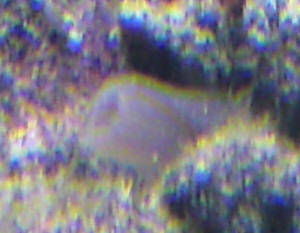
|
|
What is this? 7/3/13
I saw a question just like this but the answer was to send a better
picture so I got a more clear picture. This is growing on one of
my rocks, what is it?
<My best guess is an Ascidian (though could be an algae, sponge...). See
here:
http://www.wetwebmedia.com/ascidians.htm
Bob Fenner>
|
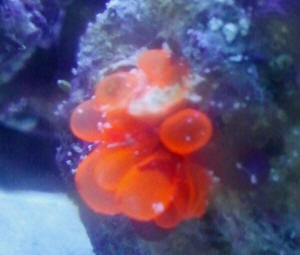 cropped and enhanced...
cropped and enhanced... |
Colony Rock Hitchhiker
6/20/13
I've been on your website numerous times but this will be the first time
<... 8.6 megs of pix...>
that I send in an inquiry. I'm still fairly new to the hobby (10 months) so
I'm always learning something new. Last March I purchased my first colony of
mushroom corals and at first, I did not notice the blatant hitchhiker. I
also did not dip my corals because I wasn't aware that it was recommended to
dip your corals before putting them in the display tank. Anyhow, I would say
that after a week or so I noticed there was something organic living on the
colony rock in plain view. I only noticed it because the "holes" closed up
while I was observing the tank. I honestly thought it was harmless because
it looks like some type of filter feeder but recently, I noticed green
bubble algae growing on the surface so now I'm not so sure if I want this
thing in my tank anymore. I was tempted to "rip" it off the rock and dispose
of it but before I rush to judge, I thought I would consult with the
experts. I have attached some pictures to help with identification. Let me
know if you need anything else. I appreciate your help!
Thanks!
Andrew
<... what amongst this is what you're referring to? Please just send one
well-resolved close up pic. B> |
.jpg) |
Re: Colony Rock Hitchhiker 6/20/13
I apologize for sending the pics at full resolution. I attached a close up
pic and I compressed it. I hope this helps.
<I thank you>
Regarding the first set of pics I sent, I wanted to include a pic of the
"filter" holes open and another pic of them closed. Since there are two
holes (one in front and one in back) I wanted to send a pic of both angles.
Again, I apologize for the unnecessary pics.
<Ohhhh, now I see what you're referring to... this is a solitary Tunicate...
A sea squirt... with other life overgrowing the bulk of its tunic/outside
body. Please see here re:
http://www.wetwebmedia.com/ascidians.htm
and the linked files above; particularly ID FAQs for the group. Cheers, Bob
Fenner> |
.jpg)
.jpg) Herdmania sp.?
Herdmania sp.? |
|
What is growing on my Crocea Clam?/Ascidian ID 3/23/12
Good evening folks,
<Hello Justin>
I purchased this Crocea clam from the LFS roughly three weeks ago.
Last evening, I noticed this hitchhiker and I’m curious what it may be.
The clam is 3” – 3.5”, so the hitchhiker pictured is fairly small.
I noticed it when the clam retracted its mantle in response to the light
array transitioning to night mode. It does not appear to have a
shell of any kind. Like the clam, it responds to light/shadow
changes by retracting what appear to be its siphons. I did not
notice this critter when I purchased the clam and my QT does not have
lighting adequate for the clams requirements so it went directly into
the display tank after a drip acclimation. Any help identifying
the creature and risks would be wonderful!
<Appears to be an Ascidian, a Tunicate and pose no risks to other life.
Is not uncommon to see Tunicates attached to bivalves in the wild.>
Incidentally, my apologies for the poor color balance of the photo.
My camera phone does not take accurately representative photos under
fluorescent lighting.
<No problem.>
Thank you,
<You're welcome. James (Salty Dog)>
Justin
|
|
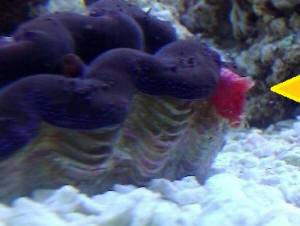
|
|
Identification: Poriferans - 9/20/11
Hi.
<Hi Kelly, Lynn here today.>
Can you please assist in the identification of the attached photo?
<I'll sure try.>
I am unsure if these are Tunicates?
<They appear to be another form of harmless, filter-feeding organism known
as a Poriferan/sponge. Tunicates tend to appear more
gelatinous and less fibrous.>
They are on the live rock in my seahorse tank and are multiplying in
number (which I hope is a sign of a healthy tank).
<Yep, no worries. These sponges tend to reside in out of the way/more
protected areas of the tank (e.g., tucked underneath overhangs, rock
crevices, behind rockwork at the back, etc.). Please see the following
link for more information/photos:
http://www.wetwebmedia.com/sponges.htm
>
Kelly
<Take care, Lynn Z>
|
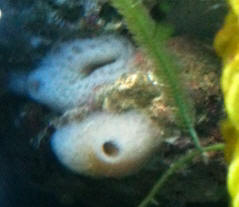 |
|
Is this an Acan? Mmm, nope 6/15/10
Hi Guys, are you able to identify this at all for me please?
<Yes>
It came on a piece of rock that has what I think is yellow polyps, feather
dusters and green Zoas on it. The guys at my LFS who sold it don't know
what it is. I have had a couple of people believe it to be an Acan from
looking at the pics but I'm still not sure when comparing photos. My
eyes are hurting from looking at so many corals on the web so any help
would be greatly appreciated!
I'm struggling to describe it but I'll do my best:
It looks like it has molded itself around the left hand side of the rock.
It is pale spotted lavender with a white and dark lavender bobbled rim
with holes in each bobble (same as described below)
I think it possibly has various slits in it with white bobbles surrounding
each slit. These white bobbles protrude out in the direction away from
the slit. Each of these bobbles has a hole in the end and it is dark
lavender around each hole.
The coral also has two small extended hollow tubes (slightly cone shaped)
next to each other which retract. These are dark lavender and white
vertically striped (see 3rd picture).
Random size holes also appear/ disappear each day and on closer inspection
these appear not where the slits are but in the places where it is pale
purple.
It twitches a lot especially when fish go past causing some of its bobbles
to retract/ deflate in places.
Here are some pictures, I'm sorry they aren't that great but unfortunately
the best I could get with my camera
Front view:
The photo shows the slits tightly closed, showing the white bobbles with
dark lavender holes pointing inwards (towards the slit). I think you can
hopefully just about make out the pale colour in the middle of each dark
marking which is the slits I was referring to. I was unable to picture
it more open don't know why, my camera just wouldn't focus on it the
second time around.
Side view:
1. 'sticky out bits' are the hollow tubes I mentioned
2. 'hole' is an example of the random holes that appear/disappear
I hope you can help me.
Thank you, Shell
<Almost certainly a colonial Ascidian. Please see here:
http://wetwebmedia.com/ascidfaqs.htm
and the linked files above. Bob Fenner>
|
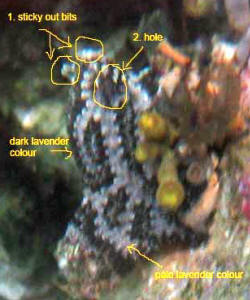 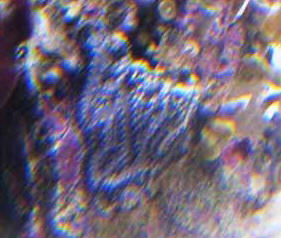 |
|
Re: Is this an Acan? 6/16/10
Thanks Bob! I came to the same conclusion having had someone point me
towards tunicates.
<Ahh, glad we're in agreement>
I am really grateful for your time in being able to verify this for me and
provide me with some excellent information on them. I shall certainly be
adding your sight to my top websites! Congratulations on a brilliant and
informative website!! All the best, Shell
<And you my friend. BobF>
|
|
Unidentified Hitchhiker 5/19/10
Hello,
<Hi there>
I recently bought a Ricordea frag that has some tubeworms and some kind of
pink stuff growing on it, but the question I have is about a little blue
guy, seen in the attached photo.
<Neat! Nice pic>
I scraped away the Ricordea it is butting against in the photo, and shot
some diluted phytoplankton at it. Today, it looks like it may be
growing.
There are darker blue spots between the yellow half-moon shapes on the tip
of the large polyp, and it looks like it may be splitting.
It is probably less than half an inch long, and translucent. It looks like
the inside is a threaded or ribbed tube. Its stem is shrouded in a
fleshy translucent tan blanket. It's soft, and reacts to touch and
feeding.
Any help identifying Mr. Blue would be appreciated.
<This is almost assuredly an Ascidian... a Sea Squirt... Not harmful...
indeed, testament to the good care all have lavished on the Ricordea
over time. Read here re:
http://wetwebmedia.com/ascidfaqs.htm
and the linked files above. Cheers, Bob Fenner>
|
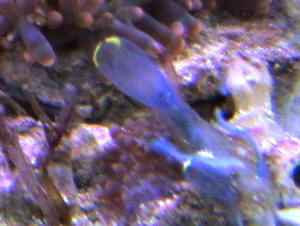 |
|
Predatory Tunicate? More Likely a Sponge
2/5/10
I got a bunch of live rock from my local fish store and when I got home I
noticed a small Grey slimy spot on one of the rocks. Since then it has
grown a lot. When I feed my fish it actually opens up what I call its
mouth (all of them) and takes what falls on it. I did put a piece of
fresh shrimp next to it and watched but it had no tentacles, but it did
have a web like covering over its mouth when it opened up, when feeding
is done it closes up again. I showed it the person that I got the live
rock from, but he had no idea what it was. If anyone could possibly know
what it is
please get back. Its driving me crazy not knowing what it is.
<I wish the photos were a little more clear, but looks like a sponge to
me.
I don't think it's a tunicate because they are generally difficult to keep
in captivity, a sponge is more likely to proliferate as you described.>
Thanks
<Welcome,
Mich><<I do agree. RMF>>
|
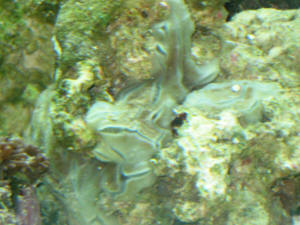 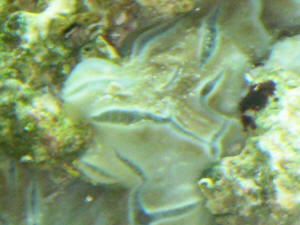 |
ID Please -- Sponge? Coral? Pest? Nope: Tunicate --
10/18/09
Hello,
<Hello Crystal, Lynn here this evening.>
I have no real way to describe this hitchhiker.
<It's a beauty!>
It is about an inch round, oval shape. Last time I thoroughly inspected the
live rock was about 3 weeks. That particular rock has been in my tank since
April (it passed through 3-4 hobbyist tanks before reaching me). It is in a
very shady spot. It seems to be uniformly attached to the rock (i.e. no
clear base like Aiptasia) and doesn't seem to react to touch, movement, or
light change. Looks kind of 'feathery'... Very pretty actually.
<Yes, indeed.>
Can you ID it? I tried Google, several marine forums, but have found
nothing.
<It looks like a neat, harmless, little Tunicate/Ascidian colony. Please see
the following links for more information/photos:
http://www.wetwebmedia.com/ascidians.htm
Something similar in the genus Clavelina (family Polycitoridae):
http://guamreeflife.com/images/organisms/fullsize/inverts/ascidians/
clavelina_moluccensis/clavelina_moluccensis_full14.jpg
http://www.ascidians.com/families/polycitoridae/Clavelina_moluccensis/clavelinamollus.htm
>
picture:
[url]http://i445.photobucket.com/albums/qq176/c_scherer123/aquarium/Saltwater/unknown1.jpg[/url]
Thanks!
<You're very welcome!>
Crystal
<Take care, LynnZ> |
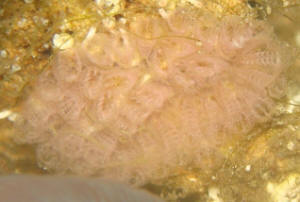 |
|
Red sponge? 10/5/09
Good evening crew-
<Morrow, Dan>
Just got these nice clove polyps, and found a bright red hitch-hiker on
them. It has now strung anchor cables to the aquarium wall. AM I correct
that it is some type of sponge?
Thanks,
Dan
<Mmm, I wish the pic was a bit better resolved and larger... But I think
this/these are Ascidians, Sea Squirts. See here re:
http://wetwebmedia.com/ascidpt2.htm
Bob Fenner>
|
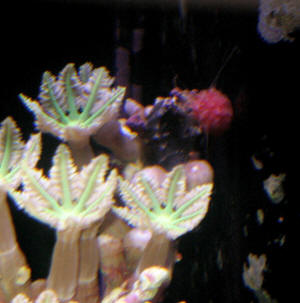 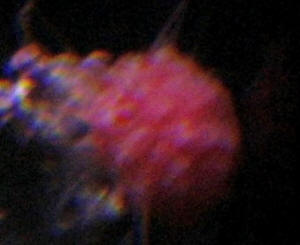
|
Re: Red sponge? - 10/06/2009
Thank you. I think the photo of the red grouping (in the link
provided) is probably my mystery guest. I'll see about getting a
better photo.
Appreciate the help.
<Real good. BobF>
Re: Red sponge?
Thanks for the reply earlier. I have one more photo, showing more of
the anchor cables and some antennae-like tentacles.
<Likely another group of organisms here...
Hydropolyps/Hydrozoans...>
Seems to be a good fit for the Ascidia family.
<Mmm... other taxon>
I wouldn't anticipate being able to keep them healthy for long in a
clean reef system. Does that sound correct?
<Are indicative of good, consistent care... Can live there. Please
see the linked files above:
http://wetwebmedia.com/ascidpt2.htm
Bob Fenner>
|
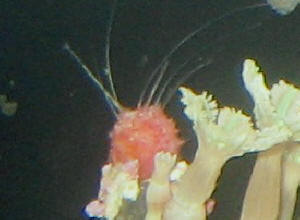 |
|
|
Fleshy tube, SW ID 9/16/09
I bought a piece of live rock last weekend with a Mushroom coral attached
to it, there was a lot of stringy algae attached which my Regal tang and
Emperor angel have eaten off revealing a clear fleshy tube poking out of
the rock, it has red vertical stripes on it and at first i thought it
might have been a feather duster as there are a few smaller ones on the
rock.
But the tube is about an half an inch long, it doesn't do anything except
occasionally retract itself when i presume it is eating, then it gently
folds out again.
<Good clues>
I had to take the rock out the other night to remove some red algae and
had a look at where the tube creature was and beneath the rock it has a
large jelly mass belonging to it!
Any help and information would be greatly appreciated.
It doesn't seem to be causing any harm, the fish go near it. Is it a cause
for concern?
<Looks to be an Ascidian. Please see WWM, the Net re. Bob Fenner>
|
 |
|
|

